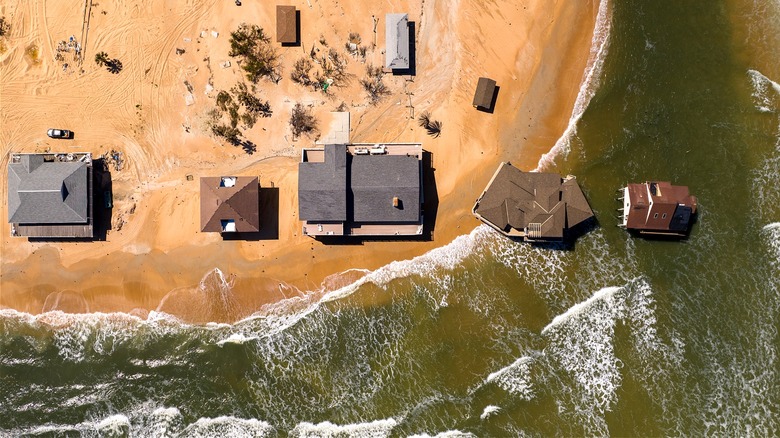The Upsetting Reason To Avoid Buying A Home In These American Cities
While increased interest rates might have you delaying any home purchases today, you could still find yourself looking into potential places to move in the future. Whether you want beautiful views, nice weather, or even bustling city energy, note you could face more limitations on your search than you originally thought. While the spike in home prices and the increasingly problematic nature of homeowners insurance are already difficult enough to navigate, there's an even bigger homebuying consideration that you might not have thought of before: climate change. In fact, climate change is increasingly becoming one of the main considerations for prospective homebuyers, and with good reason.
Increases in weather-related events combined with the potential for sky-high insurance premiums could make certain geographic places not financially feasible for your budget. As certain U.S. cities and even entire geographic regions face unique climate change-related issues, they could become decidedly less appealing options than they once were. These days, in addition to looking up potential school districts and utility companies, potential homeowners might find themselves investigating homeowners insurance claims and scouring National Centers for Environmental Information data sets on past storms in a property's area.
As climate change increasingly becomes a part of everyday life, it can be worth doing the extra research on areas to avoid buying a home. While eventually, no part of the country will be immune from the effects of climate change, in 2024, it could pay to avoid San Francisco, Cape Coral, and New York City.
San Francisco, Cape Coral, and New York City
You might be wondering why San Francisco, Cape Coral, and New York City are the three cities homebuyers may want to avoid (especially when you consider that Nebraska, Oklahoma, and Kansas are actually the states with the most expensive homeowners insurance premiums). These cities are considered by Moody's Analytics to be among the top metro areas most vulnerable, and worse off, when it comes to climate change. This determination is based on two different risk categories: long-term and short-term. The long-term risk category looks at the potential risk of long-term things like drought, extreme heat, and rising sea levels while short-term risk looks at exposure to more singular events like hurricanes, wildfires, and floods. When combining these factors, San Francisco, Cape Coral in Florida, and New York City were the metros with the most chronic physical risk from climate change hazards.
Note, San Francisco wasn't found to be especially susceptible to any singular hazard. Instead, the city has above-average risk across every single category in Moody's report. This is why it's the single most exposed large metro area in the U.S. On the flip side, New York City was especially vulnerable in one particular category, sea levels. These rising sea-level risks could eventually cripple not only the economy of the city but also the ability of residents to physically travel (since most of the city's public transportation system operates underground). None of the top three are particularly at risk of heat, unlike other top 10 at-risk metro areas like Tucson and Phoenix, Arizona.
Other things to keep in mind about location risk
There are numerous ways for climate change to affect a specific geographic region. Increased heat, hurricanes, tornado and wind storms, wildfires, rising sea levels, drought, and even flooding are all potential complications of climate change. This means that even if you avoid buying a property in a coastal region (to avoid hurricanes and flooding), you could still face tornadoes or wildfires instead. With that in mind, there are numerous states in the country that are more prone to physical risk than others, but what those risks are can vary significantly. For instance, Florida faces the highest acute physical risk threat due to its high potential for not only hurricanes but also wildfires and flooding. Similarly, Louisiana and the Carolinas face high risk across hurricanes and flooding factors. When it comes to wildfires, California, Washington, and Utah face the largest risk, while New England and West Virginia have the highest risk of inland flooding.
But beyond the physical risk of climate change-related weather events, there's also the increased financial risk. As more and more insurance companies cancel or fail to renew homeowners insurance policies in high-risk geographic areas, homeowners will be left with little to no financial protections even as storms continue to increase in frequency. For homeowners able to continue finding coverage, premiums are expected to continue skyrocketing, leaving many unable to pay for coverage on their property. In fact, per a 2023 study from the Insurance Information Institute, 12% of Americans no longer have home insurance (up from 5% in 2019).


